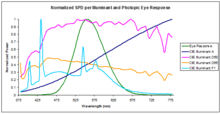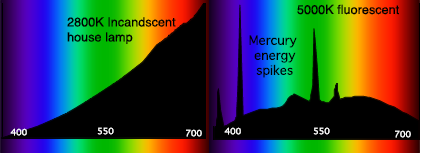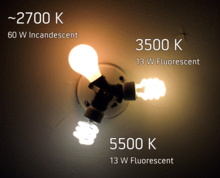Spectral power distribution

Inradiometry,photometry,andcolor science,aspectral power distribution(SPD) measurement describes thepowerper unitareaper unitwavelengthof anillumination(radiant exitance). More generally, the termspectral power distributioncan refer to the concentration, as a function of wavelength, of any radiometric or photometric quantity (e.g.radiant energy,radiant flux,radiant intensity,radiance,irradiance,radiant exitance,radiosity,luminance,luminous flux,luminous intensity,illuminance,luminous emittance).[1][2][3][4]
Knowledge of the SPD is crucial for optical-sensor system applications.Optical propertiessuch astransmittance,reflectivity,andabsorbanceas well as the sensor response are typically dependent on the incident wavelength.[3]
Physics[edit]
Mathematically, for the spectral power distribution of a radiant exitance or irradiance one may write:
whereM(λ) is thespectral irradiance(or exitance) of the light (SIunits:W/m2=kg·m−1·s−3);Φis the radiant flux of the source (SI unit: watt, W);Ais the area over which the radiant flux is integrated (SI unit: square meter, m2); andλis the wavelength (SI unit: meter, m). (Note that it is more convenient to express the wavelength of light in terms ofnanometers;spectral exitance would then be expressed in units of W·m−2·nm−1.) The approximation is valid when the area and wavelength interval are small.[5]
Relative SPD[edit]

The ratio of spectral concentration (irradiance or exitance) at a given wavelength to the concentration of a reference wavelength provides the relative SPD.[4]This can be written as:
For instance, theluminanceof lighting fixtures and other light sources are handled separately, a spectral power distribution may be normalized in some manner, often to unity at 555 or 560 nanometers, coinciding with the peak of the eye'sluminosity function.[2][6]
Responsivity[edit]
The SPD can be used to determine the response of asensorat a specified wavelength. This compares the output power of the sensor to the input power as a function of wavelength.[7]This can be generalized in the following formula:
Knowing the responsitivity is beneficial for determination of illumination, interactive material components, and optical components to optimize performance of a system's design.
Source SPD and matter[edit]

The spectral power distribution over thevisible spectrumfrom a source can have varying concentrations of relative SPDs. The interactions between light and matter affect the absorption and reflectance properties of materials and subsequently produces a color that varies with source illumination.[8]
For example, the relative spectral power distribution of the sun produces a white appearance if observed directly, but when the sunlight illuminates the Earth's atmosphere the sky appears blue under normal daylight conditions. This stems from the optical phenomenon calledRayleigh scatteringwhich produces a concentration of shorter wavelengths and hence the blue color appearance.[3]
Source SPD and color appearance[edit]

The human visual response relies ontrichromacyto process color appearance. While the human visual response integrates over all wavelengths, the relative spectral power distribution will providecolor appearance modelinginformation as the concentration of wavelength band(s) will become the primary contributors to the perceived color.[8]
This becomes useful in photometry andcolorimetryas the perceived color changes with source illumination and spectral distribution and coincides withmetamerismswhere an object's color appearance changes.[8]
The spectral makeup of the source can also coincide withcolor temperatureproducing differences in color appearance due to the source's temperature.[4]
See also[edit]
References[edit]
- ^Mark D. Fairchild (2005).Color Appearance Models.John Wiley and Sons.ISBN0-470-01216-1.
- ^abMichael R. Peres (2007).The Focal Encyclopedia of Photography.Focal Press.ISBN978-0-240-80740-9.
- ^abcWilliam Ross McCluney (1994).Introduction to Radiometry and Photometry.Boston: Artech House.ISBN0890066787.
- ^abcFranc C. Grum (1979).Optical Radiation Measurements (v. 1).New York: Academic Press.ISBN0123049016.
- ^Clair L. Wyatt (1987).Radiometric System Design.New York: Macmillan.ISBN0029488001.
- ^Wyszecki, Günter; Stiles, Walter Stanley (1982).Color Science: Concepts and Methods; Quantitative Data and Formulae(second ed.). New York: Wiley.ISBN978-0-471-39918-6.
- ^Robert W. Boyd (1983).Radiometry and the Detection of Optical Radiation.New York: Wiley.ISBN047186188X.
- ^abcWilliam David Wright (1969).The Measurement of Colour.New York: Van Nostrand Reinhold Co.
External links[edit]
- Spectral Power Distribution Curves,GE Lighting.




